
Nutrient Starved People
by Keith Addison
Published in acres, USA, June 1983, and Asian Business, February 1983
 acres, USA  Asian Business |
| Malnutrition cut Soon after this report was published, a bio-intensive organic gardening program was started in Negros Occidental, which cut the rate of malnutrition from 40% to 25% in only two years. |
|
Pollution |
|
|
|
|
|
|
|
|
|
|
Stories by Keith Addison |
| Tai Long Wan -- Tales from a vanishing village Introduction |
|
Tea money |
|
Back to basics |
|
Forbidden fruit |
|
A place where nothing happens |
|
No sugar |
|
Treasure in a bowl of porridge |
|
Hong Kong and Southeast Asia -- Journalist follows his nose |
| Nutrient Starved Soils Lead To Nutrient Starved People |
|
Cecil Rajendra A Third World Poet and His Works |
|
Leave the farmers alone Book review of "Indigenous Agricultural Revolution -- Ecology and Food Production in West Africa", by Paul Richards |
|
A timeless art Some of the finest objects ever made |
|
Health hazards dog progress in electronics sector The dark side of electronics -- what happens to the health of workers on the production line |
|
Mo man tai ('No problem') -- "Write whatever you like" -- a weekly column in Hong Kong Life magazine Oct. 1994-Jan. 1996 |
|
Swag bag Death of a Toyota |
|
Zebra Crossing -- On the wrong side of South Africa's racial divide.
|
|
Curriculum Vitae |
|
|
THE basic wealth of an agricultural society is the soil. Viewed in that light, the Philippines is on the brink of a much worse form of bankruptcy than is generally realized.
Galloping soil impoverishment has all but exhausted the country's reserves of fertility, while current crop production presents a correspondingly dismal picture of soaring inputs and slumping yields affecting every sector.
The population clearly reflects the symptoms of spiralling decline in the agricultural base, with shocking child mortality and malnutrition rates and a proliferation of deficiency-related diseases like anaemia and goiter. Cancer surgeries do a brisk trade in every rural hamlet.
Many people do not have enough food. Those who do have enough suffer nonetheless, because the food itself no longer contains the nutrients essential for health -- the soil can no longer supply them.
Not enough is being done to reverse the trend, largely because of top-level refusal to admit there is a problem.
 White hybrid rice, white bread, yellow hybrid corn and a soft-drink -- a meal free of nutrition |
But snubbing the problem will not solve it. Confidential reports by foreign agronomists working in the country have predicted general crop failure within three years, and independent soil tests support this prediction.
"A crash program to refertilize the soil on a national scale, starting now, might succeed in turning it around in about five years," a western soils scientist said. That would leave two hungry years in between.
The country's urban elite, though they may pay lip service to the Malacanang Palace mythology of national well-being, are beginning to realize this, and the dread word famine is being whispered in exclusive business clubs and around society dinner tables.
How has this happened? Ignorance, negligence and basic misconceptions about the nature of soil fertility and the production of healthy crops (faults which are by no means confined to the Philippines or to Southeast Asia) have all played their part.
Very little is, in fact, understood about the complex interactions between living and dead matter in the soil that make plant growth possible. What is clear is that fertility has to be maintained: what a crop removes from the ground has to be replaced, or the soil becomes depleted. That may sound elementary but it is far from universal practise, and in the Philippines it has become downright rare.
Just how the crop's uptake of soil nutrients is best returned to the soil is a different question. Here nature, the supreme farmer, provides the best examples. Nature's best farming practises are to be found in forests, which can maintain themselves for thousands or, in the case of tropical rain forests, millions of years without decline. Several rules are immediately clear:
- Multicropping is the rule: nature never attempts monoculture.
- Nature's farming is mixed: crops are always raised in conjunction with livestock.
- The balance between growth and decay is strictly maintained: what grows dies, and in dying is returned to the soil.
Thus the forest floor beneath the leaves contains a layer of topsoil rich in organic matter, both vegetable and animal, slowly decomposing by agency of hosts of microorganisms into humus -- the essential plant food that provides a slow release of scores of nutrients necessary for healthy plant growth in the form and balance that suits plants best.
Organic failure is certain
Fertility is a process, largely intractable to quantitative measurement. A fertile soil is alive: one hectare of good topsoil contains about 150 metric tons of organic matter, of which about 22 metric tons are living matter such as bacteria, fungi and earthworms, while the rest is in various stages of decay.
The dynamic relationships between the various types of decaying matter to each other and to the microorganisms which digest them, and of these to each other, and of all these factors to the plant, are complex in the extreme and may possibly never be fully understood. But the system can be emulated.
The traditional Chinese farming system is one that has copied nature successfully. After 4,000 years there has been little decline in the fertility of China's topsoils and no decline in crop yields.
There is little monoculture in China: farmers long ago developed what remain one of the world's best multicropping and crop rotation systems, with one crop replacing what another takes out and the various crops protecting each other from pests and disease.
Crops and livestock are raised together, and growth and decay are balanced: all waste matter -- vegetable, animal and human -- is faithfully returned to the soil.
In the Philippines, that is not the case. Most cropland soil is virtually dead, the microorganisms killed by chemicals. There is a serious lack of organic matter.
Where good topsoil should contain 5% of organic matter, soil test results of typical Philippine rice, sugar and coconut lands in Luzon, Negros and Mindanao show organic content levels of 1.17%, 1.04%, 0.62%, 0.28%, 0.08%, and in some cases nothing at all.
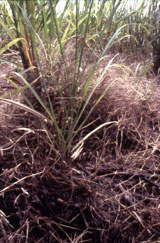
This sugar farm is dead, the "crop" not even worth cutting. The previous crop wastes lie on the ground, still fresh and undecayed after a year
Year after year these have been monoculture farms growing just rice or sugar. There is little or no mixed cropping or crop rotation. There is also little or no livestock in evidence, except in concentrations largely divorced from the cropping systems.
The two essential components of the all-important humus content of a fertile soil are absent: the soil receives little animal manure, and except for the discarded roots of harvested crops, little or no crop waste is returned to the soil as green manure. Hence the lack of organic matter.
The soil tests also showed dangerously low or nonexistent levels of many of the major elements required for plant nutrition.
The farmers' and the Ministry of Agriculture's answer to this is simplistic. The main cause of the problem is an over-reliance on chemical fertilizers; but the solution now offered to the impoverishment caused by this over-reliance is ever greater doses of the same medicine.
There is nothing intrinsically wrong with using chemical fertilizers, though some are better than others. The mistake lies in thinking that they provide the complete answer to fertility maintenance. They can be efficient when used in conjunction with organic fertilization such as compost, manure or recycled crop wastes; but while they can supplement it, they can never supplant humus in the soil -- and the source of humus is organic matter, not chemicals.
To grow at all, rice, sugar and other plants require six essential nutrients known as macro-elements: nitrogen (N), phosphorus (P), potassium (K), calcium, sulphur and magnesium. There are another 52 micro-elements, five or six of which are necessary to have anything like a decent yield and several more for the crop to be a nutritious one (in the case of rice). For a good crop, at least 20 of them should be readily available in the soil.
That is also simplistic, for it says nothing of the subtle synergistic effects of those elements in combination with each other upon plant growth and it ignores the complex nature of humus. But how much more simplistic is the attitude that the whole problem can be satisfactorily solved by replacing the crop's uptake solely with chemical fertilizers containing nitrates, phosphates and potash in various forms, strengths and combinations, and nothing else?
The NPK mentality
This attitude has been called "the NPK mentality". It is at the root of many of the world's current food problems. During the past 25 years it has gained a stranglehold on the Philippines, displacing traditional, more sustainable practises until it is now virtually the only attitude left.
On plantation lands such as the sugar estates, the previous practise of leaving fields fallow for one season in rotation so that the soil can regather some of its strength has been squeezed out by the falling economics of sugar production. Most sugar planters now rely solely on NPK fertilizers.
With crops such as rice, the so-called "Green Revolution" has brought high-yielding varieties which come in complete seed, NPK fertilizer and pesticide packages, displacing the old methods of organic fertilization. The result has been depleted soils and poor crops. Only in Baguio, whose market gardeners are expert organic farmers, is the picture different.
It can fairly be said that the authorities -- the Ministry of Agriculture, the Bureau of Soils (BoS), bodies such as the Philippines Sugar Commission (PhilSuCom) -- have little idea of the true condition of the country's croplands.
The Bureau of Soils laboratory at their provincial headquarters in Bacolod City, Negros Occidental, consists of a couple of porcelain sinks, some glass jars, thermometers and test tubes, a chemical balance, and a table supporting rows of small manila packets containing soil samples waiting for testing. The staff is two young men and a typist.
In charge is supervising soil technologist E.M. Gregorius, who is to be found at the Ministry of Agriculture headquarters a block away. He said the laboratory could handle up to 20 samples a day. Most farmers only sent one sample, which is tested for N, P and K and for pH -- the acid/alkaline level on which lime applications are based.
Tests for other macro-elements and for micro-elements such as iron or iodine were available on request from the regional laboratory in Ilo Ilo in Panay, he said, though there were very few requests for such tests.
The bureau, Gregorius said, produced fertilization recommendation maps for the province for N, P and K plus lime. There was no detailed map of soil types apart from an old map dated 1948 hanging on the laboratory wall, showing broad areas color-coded for soil types of the whole island of Negros.
The inadequacy of this becomes clear when it is compared to the work accomplished on a single 140-hectare Negros sugar farm by a foreign soils scientist retained by the planter because neither the BoS nor PhilSuCom had been able to allay his suspicions that all was not well with his soil.
Thorough tests had found 16 different soil types on this one farm with more than 90 soil profiles from field to field. Specific fertilization programs based on these results, including a certain amount of organic recycling, had not only improved the yields, but had saved the farmer P150,000 in fertilizer inputs for the first year.
In complying with the official recommendations, he had been heaping expensive potash on already potash-rich soils year after year while his fields were starving for want of several cheap micro-nutrients and organic matter.
At the national headquarters of the BoS in Manila, German Jonas, head of the soils analysis section, admitted that the BoS could not provide such a field-by-field analysis for NPK only, and certainly not for micro-elements. The Bacolod City laboratory "certainly needed strengthening", he said, but his own laboratory was well-equipped to conduct micro-element tests.
Could his laboratory test for the availability of the micro-element iodine in the soil? He had recently received several requests for iodine tests, though he did not know why people wanted them all of a sudden. But he could not find a method to test for iodine and was searching for one.
Disbelief
Soils scientists questioned in Hong Kong expressed disbelief at this: the iodine test, they said, was a chemical test basic to soils science and was detailed in any text book on the subject.
The reason that Jonas had been receiving requests for iodine tests is that the Philippines is now rife with goiter, an iodine-deficiency disease, because the exhausted cropsoils can no longer supply it to the food they eat. That the iodine test is so far beyond the horizons of the BoS is an example of the NPK mentality at work.
Following a global study last year, a Food and Agriculture Organization (FAO) soils bulletin, which the BoS must have received, pointed out several soil nutrient deficiencies in the Philippines and warned of an accelerated exhaustion of micro-elements in soils and of the possible geomedical consequences for humans.
In Bacolod City, opposite the desk of soils technologist Gregorius, sits S. Parohinog, who is in charge of Ministry of Agriculture extension officers serving rice farmers in the province.
His officers, he said, recommend to all farmers, regardless of the condition of their soils, that they apply 80 kilograms N, 30 kilograms P and 30 kilograms K for the first crop of rice and 100 kilograms N, 30 kilograms P and 30 kilograms K for the second crop.
But what about Gregorius' fertilization maps? He brushed the question aside: "It doesn't matter much," he said. "Most of the small farmers can only afford about half the recommended input anyway." What about organic input? "We have a new plan, in the irrigated areas only, promoting the use of azolla as an organic fertilizer," he said.
Azolla, a pond weed, provides the soil with organic matter rich in nitrogen, cutting by half the nitrate component in fertilization programs. It also helps to keep weeds down, cutting herbicide costs, while increasing the yield considerably -- a good example of what organic fertilization can accomplish.
This is not new: the nitrogen-fixing properties of the unique azolla/blue-green algae symbiosis have been in widespread use in the ricelands of China, Korea and Vietnam for at least 1,500 years.
In the Philippines, some 5,000 hectares of irrigated lands now use azolla, but the vast majority of irrigated farms and all the rain-fed and upland farms still rely on usually inadequate amounts of NPK fertilizers.
Growth medium eroded
Another serious aspect of the soil problem is the rate of erosion. Huge amounts of topsoil are washed away every time it rains, and the loss is accelerated by the breakdown of soil structure caused by the mechanisms of fertility depletion.
The situation is greatly worsened by the rate of deforestation, with millions of hectares of forest land denuded annually, mainly by illegal loggers and kaingeros (slash-and-burn farmers).
As the trees and ground cover are lost, the exposed soil washes away, strangling irrigation systems and silting up rivers, which then flood croplands, destroying crops and washing away yet more topsoil.
In some areas, irrigation systems are so badly silted that it has been suggested that underground water sources be utilized instead.
The official answer to these problems centres on the intensive promotion of ipil-ipil cultivation. A fast-growing legume, "fixing" nitrogen from the atmosphere and making it available in the soil for plant growth, ipil-ipil was presented as a wholly useful tree.
It would solve the reforestation problems, reverse the spread of erosion, refertilize the soil with its nitrogen-fixing capabilities, provide millions of metric tons of saleable wood for use as fuel and lumber, and solve the problems of the landless kaingeros who were encouraged to cultivate it.
But the scheme has failed. Experience has shown ipil-ipil to be far from the grow-anywhere tree it was supposed to be. It will not thrive on the poor soils and eroded upland slopes it was intended for and can even contribute to further soil depletion, while timber yields have seldom equalled targets.
Victorias Milling Corporation in Negros Occidental, which had switched to dendrothermal (woodburning) technology to save fuel costs, was forced to spend thousands of pesos per hectare last year on revitalizing its ipil-ipil plantations or face fuel shortages.
Given the same problems, kaingeros continue to slash and burn, causing further erosion.
Far from being the ideal restorer of marginal lands and ex-forests, ipil-ipil, like other crops, has been found to thrive best on good agricultural land, which it certainly doesn't deserve. It can be ruled out of the soil fertility question.
Much of the damage could be repaired and large amounts of money saved if locally available organic wastes could be recycled to the soil.
Large-scale waste recycling could effect huge savings through import substitution of expensive chemical fertilizers. Hundreds of millions of pesos could be saved this way, which could be applied to the costs of refertilization.
Waste recycling presents problems in the Philippines. Application of potash-rich rice straw, the composting of sugarcane tops instead of burning them, or the collection and application of animal manures are matters of education.
But returning the mountains of rice husks piled outside the rice mills to the farms in the form of usable, silica-rich ash presents considerable logistical problems, which also apply to wastes such as coconut husks -- a rich source of potash -- and distillery slops, which are rich in nitrates.
Wasted garbage
The real dividends, however, and also the greatest difficulties, lie in the cities. The organic-rich garbage of Manila could supply the starving soils with about 300,000 metric tons of compost a year, and that of the other cities, towns and villages could add a further 2,500,000 metric tons.
In a special inquiry last year, Manila Vice-Governor Ismael A. Mathay, Jr., found that the city's Environmental Sanitation Centre, which is responsible for Manila's garbage collection, was riddled with graft and incompetence.
Despite its staff of 12,000 and its massive funding of P200 million a year (almost half the city's total budget), a huge proportion of the garbage was not even being collected but mouldered instead in the streets, constituting a major health hazard.
What garbage is collected is another problem. Two Japanese composting plants are to be built, which will be useful; but enormous mounds of trash on dumpsites still constitute a disposal problem not solved by a P0.8 million World Bank-funded study which has recommended sanitary landfill -- though that is impossible because of Manila's high water table.
The obvious answer is to link the disposal problem to the needs of the soil. But are the city authorities capable of accomplishing this? Past performance does not imbue confidence. More likely the city will continue to drown in its wastes while the the land continues to starve.
Crop pests
Lack of nutrients is not the only threat to the crops. Malnourished plants, like malnourished people, are prone to disease, and crops are now extremely vulnerable -- especially the rice crop.
To see crop pests in perspective, one should return to the example of the forest, where every form of plant and animal pest and disease is found, and yet fauna and flora populations are maintained at a peak of health and virility. Here disease and pests play a role similar to that of the predator.
As an example, research has found that Canadian wolf packs ensure that only the fittest caribou survive; without the wolves, the health and quality of the herds soon decline.
Disease and pests are thus promoters of health -- nature's mechanism for removing poor specimens and returning them to the soil.
Crops in the Philippines are under heavy attack by a wide variety of pests and diseases; the favoured solution is, of course, pesticides.
But apart from their side-effects (unacceptable environmental damage, plus some 375,000 reported poisonings a year in the Third World), pesticides just don't work well.
Highly adaptive pests quickly develop resistance to them, outpacing the use of ever higher dosages and the introduction of new poisons. It is a losing game.
Like the NPK mentality, of which it is an offshoot, the poison approach is simplistic. In combination, the two misconceptions can be devastating.
For instance, sugar and rice are both mycorrhizal plants; unlike legumes, they cannot fix nitrogen from the atmosphere and must gain their nutrition from the soil. That is facilitated by a symbiotic association with mycorrhiza soil fungi, which digest humus in the soil and are then in turn digested by the plant roots.
It has been shown that chemical fertilizers either destroy the vital fungi or render them indigestible by the plant, whose feeding is then impaired.
Those same fungi have been found to be inimical to nematodes, microscopic parasites that feed on roots, several varieties of which infest Philippine sugarcane crops, to the detriment of the plant's health and its yield.
Recommended treatment is the application of carbofuradan insecticide, setting off the futile chain of resistance and higher dosages and effectively murdering what vestiges of mycorrhiza might have survived the chemical fertilizers, further weakening the plant.
A South Negros sugar planter, put off chemicals by the rising costs of inputs and slumping yields as well as by the fact that his manager's children had been poisoned by carbofuradan, applied only organic fertilizer to two of his eight nematode-infested sugar fields and the usual chemicals to the other six.
Without the use of any pesticides, the nematodes disappeared from the organically-fed fields as the mycorrhiza fungi recovered. The plants, freed from nematodes and with their main food source restored, delivered a much improved yield. Costs were reduced and production increased.
Green Revolution
Traditional rice culture, using organic fertilizers and a wide variety of native strains -- which over the centuries had developed immunities to local pests (in other words, they had passed nature's fitness test) -- has been practically wiped out by the new technology of the Green Revolution, and the hardy and nutritious native strains are now hard to find or lost.
The response to the introduction of the new dwarf hybrid strains, with their high yields (and low nutritional value) and their reliance on an artificial environment of chemical fertilizers and pesticides, was what the International Rice Research Institute (IRRI) terms "an unexpected buildup" of pests and diseases which soon became resistant to the pesticides.
The IRRI scientists responded by finding stronger pesticides and developing ever more new strains with built-in resistance to the pests.
That led to what is called mono-gene domination of the rice crop. Instead of the variety of native strains with their various immunities, the crop came to depend on the survival of one strain only with its test-tube resistance.
In 1973-74 the Philippines rice crop was almost wiped out by tungro, a virus disease carried by the brown plant-hopper -- an insect pest which keeps developing new biotypes resistant to the latest crop strain's immunity to it. In 1975 Indonesian farmers lost half a million acres of rice to damage caused by the rice hopper.
IRRI hastily produced new resistant strains, but this resistance only lasts for a couple of years before the strain has to be replaced. Rice is now threatened by 23 pests and diseases.
In the long run, who will win this extraordinary duel: nature's troops or the IRRI scientists? Is it sensible to put an entire nation's eggs in one basket like this?
It has been shown that, given good soil, traditional varieties can equal the new hybrids in yield while far surpassing them in both disease resistance and nutritional value, without the need for artificial fertilizers and pesticides. Again, the key is the soil.
It has also been shown that the high yields attained with the hybrids on the experimental stations cannot be reproduced even on rich farms, and most farms are anything but rich.
Some of the larger mechanized, irrigated farms achieve yields of up to 6,000 kilograms per hectare. In fact, this is a poor harvest and barely economical; it compares poorly with the yields of up to 30,000 kilograms per hectare not uncommon in Japan.
Most farms, however, can produce only 1,500 to 4,000 kilograms per hectare, on which they can hardly feed themselves. Despite the official line from Manila, they do not have access to the credit and assistance provided only to richer farmers. It simply does not reach them. They cannot afford the necessary inputs.
The country's millions of landless peasants and seasonal labourers are far worse off. Many are the rice terraces hewn with incredible labour from upland slopes and tragically abandoned after only a year when the ground failed to yield a crop at all -- meaning the end for that family.
Had they used native rice, they would have got some crop at least. But hybrid seeds are now virtually the only seeds available and they will not grow without the expensive inputs that these people have no access to.
While the benefits of the new technology have meant that the Philippines has, since 1977, turned from importing rice to producing exportable surpluses (200,000 metric tons last year), that does not mean, as claimed by Manila, that the country is now self-sufficient in rice. It simply indicates an inequitable distribution of resources, as is confirmed by soaring malnutrition rates.
With the country's high population growth, there will be between 85 million and 100 million people to feed by the year 2000; and with lands devoted to export crops like sugar and coconut oil remaining unavailable for food cultivation, despite their tumbling yields and failing markets, all those mouths will have to be supplied by the same land which is failing to feed the current population.
There is only one way to achieve the required production increases on those lands -- not by developing new hybrid strains that will grow in deficient soils, which is the method adopted by IRRI, but by attending to the soil itself.
See also:
Seeds of the world -- Journey to Forever
Treasure in a bowl of porridge
Ricefields are increasingly being given over to the production of yellow hybrid corn such as this Hycorn 9 recommended by the or condition, the application at planting of six bags of 14-14-14 per hectare, and, 25 to 30 days after planting, of a side-dressing of three bags of urea or five bags of ammonium sulphate per hectare -- all NPK fertilizers -- as well as four separate applications of various insecticides and weed killers. According to an American nutritionist, hybrid corn lacking the nutrition-rich germ is as nutritional as tissue paper. However, it is not meant for human consumption, but for feeding meat animals (which are meant for human consumption). But even pigs are reported to be reluctant to eat it unless it is supplemented with molasses. Manuel Garcia is an uplands smallholder who prefers to follow the farming methods of his forefathers and has prospered as a result.
Pollution With the slump in exports and prices, excess sugar is being diverted to alcogas production to substitute for petroleum fuel imports. The production of one litre of alcohol produces 10 to 12 litres of distillery slops which -- when applied to sugar fields and added to irrigation water -- have been shown to increase yields. The slops can also be cheaply concentrated into an effective and saleable nitrogen-rich organic fertilizer. But Victorias Milling Corporation's alcogas plant at Caren in North Negros prefers to tip its slops into this river, killing fish in downstream fish farms and polluting a wide area with foul and noxious nitrate fumes.
With the slump in exports and prices, excess sugar is being diverted to alcogas production to substitute for petroleum fuel imports. The production of one litre of alcohol produces 10 to 12 litres of distillery slops which -- when applied to sugar fields and added to irrigation water -- have been shown to increase yields. The slops can also be cheaply concentrated into an effective and saleable nitrogen-rich organic fertilizer. But Victorias Milling Corporation's alcogas plant at Caren in North Negros prefers to tip its slops into this river, killing fish in downstream fish farms and polluting a wide area with foul and noxious nitrate fumes.
Back to top
Poisoned rice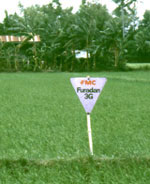 FMC's Furadan kills insects, but it doesn't stop them from coming back because they develop a resistance to it. It can also kill animals and people. In 1978 it was banned in the Philippines for use on the edible parts of plants and banned altogether for use on rice. But it is still widely used on rice crops, as this August 1982 photograph indicates.
FMC's Furadan kills insects, but it doesn't stop them from coming back because they develop a resistance to it. It can also kill animals and people. In 1978 it was banned in the Philippines for use on the edible parts of plants and banned altogether for use on rice. But it is still widely used on rice crops, as this August 1982 photograph indicates.
Back to top
Ipil-ipil, the 'magic tree'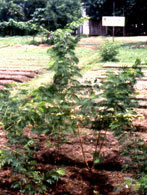 This is a Bureau of Forest Development nursery. A research team assessing the performance of an ipil-ipil scheme was told by the Bureau's Manila headquarters, and again by the provincial office, that 400 hectares were under ipil-ipil cultivation in the scheme. The mayor's office in the local town told them the actual area was 200 hectares, and the local forestry official amended this to 100. They went to see for themselves and found rather less than 50 hectares of ipil-ipil trees, with the trees growing at about one-fifth of the targeted rate -- amounting to only 2.5% of the production counted on in Manila.
This is a Bureau of Forest Development nursery. A research team assessing the performance of an ipil-ipil scheme was told by the Bureau's Manila headquarters, and again by the provincial office, that 400 hectares were under ipil-ipil cultivation in the scheme. The mayor's office in the local town told them the actual area was 200 hectares, and the local forestry official amended this to 100. They went to see for themselves and found rather less than 50 hectares of ipil-ipil trees, with the trees growing at about one-fifth of the targeted rate -- amounting to only 2.5% of the production counted on in Manila.
Back to top
Young, poor and hungry This underweight, swollen-bellied child seldom smiles; but he is luckier than others. "The big growth industry around here is the manufacture of little coffins," said a despondent rural health worker. According to the Nutrition Centre of the Philippines, half of all deaths recorded annually are of children under five, and half of these deaths are directly related to malnutrition. Of the country's 9 million children less than six years old, less than a third have normal growth rates and more than a third are actively malnourished -- suffering from serious diet deficiencies. Of children aged from one to six, 75% are anaemic (suffering from lack of iron) and 75% are deficient in vitamin A (which leads to eye disease and blindness). More than a third of school-aged children are malnourished. Regional studies of pregnant and lactating women have found that 21% are anaemic and 41% suffer from goiter (caused by lack of iodine.)
This underweight, swollen-bellied child seldom smiles; but he is luckier than others. "The big growth industry around here is the manufacture of little coffins," said a despondent rural health worker. According to the Nutrition Centre of the Philippines, half of all deaths recorded annually are of children under five, and half of these deaths are directly related to malnutrition. Of the country's 9 million children less than six years old, less than a third have normal growth rates and more than a third are actively malnourished -- suffering from serious diet deficiencies. Of children aged from one to six, 75% are anaemic (suffering from lack of iron) and 75% are deficient in vitamin A (which leads to eye disease and blindness). More than a third of school-aged children are malnourished. Regional studies of pregnant and lactating women have found that 21% are anaemic and 41% suffer from goiter (caused by lack of iodine.)
Back to top
The NPK mentality at work
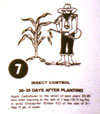 Barefoot crop-spraying: from the Maisagana Program leaflet, Basic Steps to Successful Hybrid Corn Culture
Barefoot crop-spraying: from the Maisagana Program leaflet, Basic Steps to Successful Hybrid Corn Culture
 Maisagana grain program and supported by the KKK livelihood program. Posters and leaflets distributed by the Ministry of Agriculture recommend, regardless of soil type
Maisagana grain program and supported by the KKK livelihood program. Posters and leaflets distributed by the Ministry of Agriculture recommend, regardless of soil type
Back to top
Disposal problem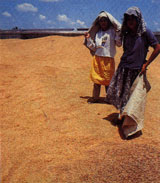 Mountains of rice hull outside every rice mill constitute a disposal problem, despite schemes to use it for fuel or as a base for particle board manufacture or even as an animal feed, though it lacks protein. Rice hull is 83% silica and rice needs silica to grow, but little rice hull is returned to the soil in the Philippines.
Mountains of rice hull outside every rice mill constitute a disposal problem, despite schemes to use it for fuel or as a base for particle board manufacture or even as an animal feed, though it lacks protein. Rice hull is 83% silica and rice needs silica to grow, but little rice hull is returned to the soil in the Philippines.
Back to top
Starving animals These products of a national cattle dispersal scheme sponsored by First Lady Imelda Marcos' KKK livelihood and development program were received in this condition from a Bureau of Animal Industries stock compound. The BAI 'had no budget to feed them'. The farmer whose livelihood they were intended to develop lacked pasture and was feeding them on protein-deficient sugarcane tops.
These products of a national cattle dispersal scheme sponsored by First Lady Imelda Marcos' KKK livelihood and development program were received in this condition from a Bureau of Animal Industries stock compound. The BAI 'had no budget to feed them'. The farmer whose livelihood they were intended to develop lacked pasture and was feeding them on protein-deficient sugarcane tops.
Back to top
'Sweat of the brow' fertilizer
"There was nothing when I came here 20 years ago. I had nothing, not even a bolo (machete), just a small knife. Now I have a good farm and even some money in the bank.
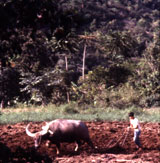
Ploughing deep
"Everything grows well here. I have all kinds of fruit trees, rice, corn, vegetables, some coffee and some sugar, chickens and ducks and some pigs. Yet other farmers did not want this land. They said nothing would grow on it.
"The trouble is that they are lazy. They do not want to plough deep, it is too much trouble for them. But if you don't plough deep, the rain washes away the topsoil. If you plough deep enough, it soaks through the topsoil into the subsoil.
"When I harvest my corn, I do it myself. I won't let anyone help me. I take the corncobs and then I chop the rest of the plant, the stalks and the leaves into small lengths so I can plough it back into the soil with some manure.
"The waste from the plants is just as good as chemical fertilizer and it costs nothing. It is the same with the other crops. I put the waste back or I make compost with it.
"But my neighbours don't do this. They burn the waste instead. It is easier that way; they will not plough it in because that makes ploughing more difficult. They see that my crop is better and that I save money, but they are too lazy to follow me.
"I don't need insecticides here. I don't spend money on them. Only a few plants are attacked by insects. It is no problem. I grow native rice. It is better to eat than the new rice, and cheaper to grow. The yield is good, and I can use the seeds for the next crop.
"With the new rice you cannot use the seeds again; you must buy new seeds each time. And the insects like the new rice. You need to use insecticides. Most people use the new rice now. The native rice is becoming hard to find. But they cannot afford the fertilizers and the insecticides for them, so their yields are bad.
"They cannot get crop loans. It is said that they can get loans, but you can only get a loan if you have money. Most of these people have no money -- they are all in debt.
"There are about a thousand families here, but only about 70 own their land. If you don't own the land, you cannot get a loan. Even those who own their land are struggling. Many people are hungry; many are sick, but there is no clinic here."


















